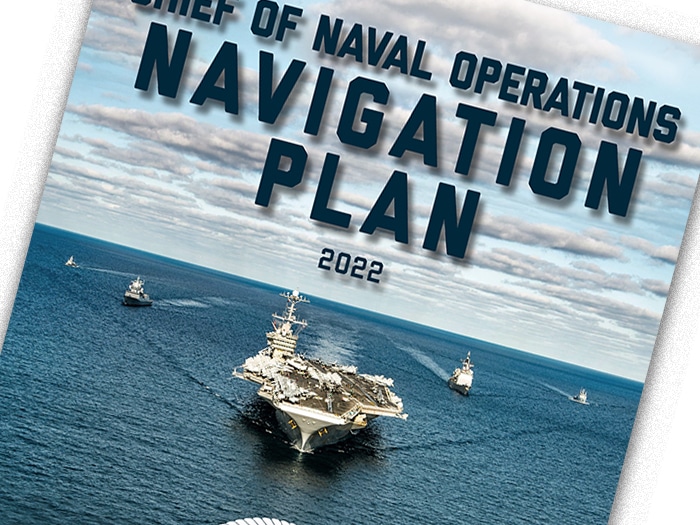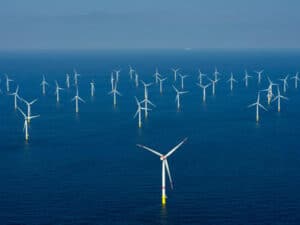
CNO’s vision for hybrid future fleet: 350 manned ships and about 150 large unmanned platforms
Written by Nick Blenkey
Chief of Naval Operations (CNO) Adm. Mike Gilday has released Navigation Plan 2022 to the fleet. It aims to outline how the U.S. Navy “will build, maintain, train, and equip a dominant naval force to strengthen strategic partnerships, deter conflict, and if called upon, help win the nation’s wars.”
“Past and ongoing threat-informed analysis, both inside and outside the Department of Defense, underscores the need for a more capable, larger Navy,” says the document. “The Navy must set a sustainable trajectory now to ensure we remain the combat-credible maritime force our nation needs in the future. Retiring legacy platforms that cannot stay relevant in contested seas—and investing in the capabilities we need for the future—is essential for our national security.”
HYBRID FLEET
“The Navy must become a hybrid fleet,” says Navigation Plan 2022. “Manned, multi-mission platforms will remain at the core of our future fleet, but augmented with new platforms and new capabilities. We will add to our current fleet a host of manned, unmanned and optionally- manned platforms operating under, on, and above the seas. This future fleet will deliver an assured strategic deterrent; greater numbers of undersea capabilities; a mix of large and small modern surface combatants; and a resilient logistics enterprise that can sustain our distributed naval force.”
“In the 2040s and beyond, we envision this hybrid fleet to require more than 350 manned ships, about 150 large unmanned surface and subsurface platforms, and approximately 3,000 aircraft,” says the plan, which forecasts the future fleet to consist of:
- Columbia-class ballistic missile submarines to provide America with an assured deterrent to any strategic attack on the Homeland. (Capacity goal: 12)
- Nuclear-powered aircraft carriers, which will remain the most survivable and versatile airfields in the world, to provide long-range, persistent sea control, power projection, and organic sensing in contested seas, as well as flexible options across the spectrum of conflict. (Capacity goal: 12)
- Nuclear-powered fast-attack and large payload submarines to hold adversaries at risk in both contested seas and open oceans. We will continue to build the Virginia-class at a sustainable rate while developing the SSN(X). (Capacity goal: 66)
- Large and small surface combatants to sustain free and open seas, including DDG(X) next-generation guided-missile destroyers and Constellation-class frigates, capable of defending the fleet, striking adversary forces in all domains, and expanding interoperability with allies and partners. (Capacity goal: 96 Large and 56 Small)
- Amphibious ships, including a core of amphibious assault ships to support Marine Expeditionary Units, and light expeditionary ships to provide maritime maneuver for Marine Littoral Regiments. (Capacity goal: 31 amphibious assault and 18 Light Amphibious Warships)
- Unmanned surface and subsurface platforms to increase the fleet’s capacity for distribution; expand our intelligence, surveillance, and reconnaissance advantage; add depth to our missile magazines; supplement logistics; and enhance fleet survivability. This transition will rebalance the fleet away from exquisite, manpower- intensive platforms toward smaller, less-expensive, yet lethal ones. (Capacity goal: Approximately 150)
- Combat logistics ships and auxiliary vessels to include replenishment ships, submarine and unmanned platform tenders, repair ships, salvage ships, and hospital ships. The combat logistics force, including the next-generation logistics ships, will be sized to ensure the appropriate capacity to refuel, rearm, and resupply a maneuvering, distributed fleet at sea. (Capacity goal: 82)
- Expeditionary logistics in sufficient capacity to provide in-theater sustainment capabilities to a distributed expeditionary shore infrastructure, including forward damage repair, mobile construction, cargo handling, and medical services.
- Flexible, long-range, and lethal carrier-based aircraft, consisting of a mix of 5th Generation manned aircraft and Next Generation Air Dominance Family of Systems. (Capacity goal: Approximately 1,300)
- Aircraft for anti-submarine and anti-surface warfare, to include helicopters and maritime patrol and reconnaissance aircraft, all augmented by unmanned aviation systems. (Capacity goal: Approximately 900)
- Support aircraft, including intra-theater lift, training, and research and development. (Capacity goal: Approximately 750)
- Information Warfare capabilities to counter adversary forces, complete kill chains, connect fleet platforms, and persistently cover the battlespace to ensure decision advantage.
“We will augment the force with an evolving complement of thousands of small, rapidly adaptable, and attritable unmanned platforms. These enablers will increase our sensing resilience, persistence, and coverage, provide cross-domain kinetic and non-kinetic effects, and enhance the survivability and sustainability of the future fleet.”
Download Navigation Plan 2022 HERE
Meantime, all of this has to get Congressional approval and the Congressional Research Service has just released its most recent “Navy Force Structure and Shipbuilding Plans: Background and Issues for Congress” which puts some perspective on what will be required to translate the CNO’s vision into legislated and authorized reality.
Download the new CRS report HERE




